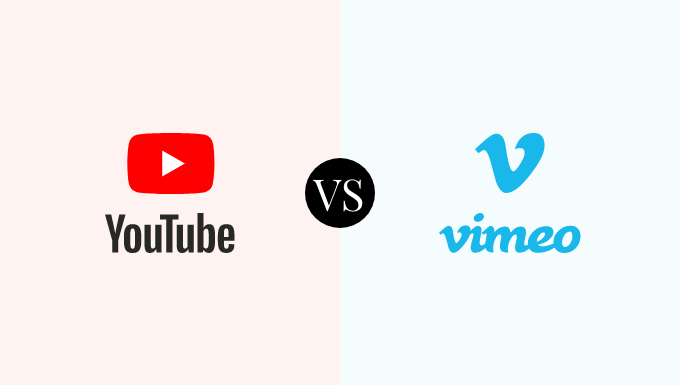YouTube vs Vimeo – Which One is Better for WordPress Videos?
Are you looking for a YouTube vs. Vimeo comparison to find out which one is better for embedding videos in WordPress?
When it comes to uploading videos online, YouTube and Vimeo are the two most popular platforms on the market. They are both great, but they have their own pros and cons.
In this article, we will compare YouTube vs. Vimeo and share their pros and cons to help you choose a platform for your WordPress videos.
Why Use a Hosting Platform for WordPress Videos?
If you want to start a blog, then WordPress is the most popular blogging platform, used by 43% of all websites.
Many blogs include videos in their content to make it more engaging. While you can directly upload your videos to WordPress, it is not designed to stream videos.
This is because videos are large files, and most WordPress hosting providers don’t offer servers optimized for video streaming. If multiple users access videos on your website at once, then this could crash your server and increase bandwidth usage.
Plus, each user has a different type of internet connection, meaning your high-quality videos will take forever to load on slower internet connections.
On the other hand, you can use video hosting platforms like YouTube or Vimeo that are designed to serve videos. They have server resources and technology to offer a far better video streaming experience than WordPress.
Plus, you can easily embed these videos in WordPress to improve your site’s SEO, monetize your content, and build a community around your brand.
For more on this topic, see our guide on why you should never upload videos to WordPress.
That being said, let’s take a look at YouTube vs. Vimeo to find out which one is better for your WordPress videos. Here is an overview of the topics we will cover in this comparison:
1. Pricing
Both YouTube and Vimeo are for-profit companies, and their pricing options are based on how they make money online.
YouTube
YouTube has a completely free plan that comes with unlimited storage and bandwidth.
This is because YouTube mainly earns money by showing advertisements on the platform. These ads are displayed inside the YouTube video player, the sidebar, and the YouTube app.
As a content creator, you can upload as many YouTube videos as you want in the free plan. You can even host YouTube live streams on your channel.
However, it has some limitations, as you cannot upload videos larger than 15 minutes or monetize your videos with ads.
You can easily increase this limit by verifying your account. You will need at least 100,000 subscribers to get verification.
Additionally, users can purchase a YouTube Premium subscription if they want to get ad-free viewing, video downloads, and more. Premium plans start at $13.99 per month.
Vimeo
Vimeo’s business model is quite different from YouTube’s because the platform makes money by selling video hosting services. This allows publishers and small businesses to offer an ad-free viewing experience to their users.
Vimeo even has a free plan that you can use. However, it only allows you to create up to 2 videos per month (with a total of 25 videos) and is limited to 500 MB of weekly storage.
Alternatively, you can sign up for Vimeo Starter, Standard, or Advanced plans to access more features.
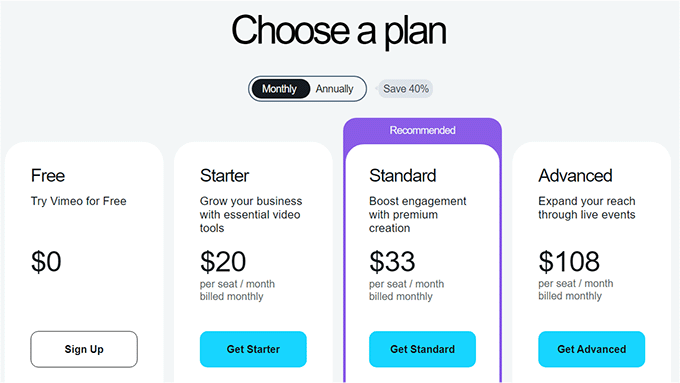
If you are just starting your business, then we recommend getting the Starter plan for $20/month, which allows you to upload 60 videos on Vimeo.
2. Upload Limits
YouTube and Vimeo have different policies regarding how much video content you can upload on these platforms.
YouTube
By default, you can upload unlimited videos with YouTube’s free plan, but each video should be under 15 minutes.
However, after verifying your account, you can upload videos with up to 12 hours of playback or a 128GB file size.
You can easily create a verified account on YouTube by providing your phone number and then adding the verification code sent on your mobile. Note that you will need at least 100,000 subscribers to get verified.
This is very generous and fairly reasonable for all types of content creators.
Vimeo
On the other hand, Vimeo has different limitations on the upload size for each plan.
- Free: 500 MB per week and up to 5 GB total
- Plus: 5 GB per week up to 250 GB per year
- Pro: 20 GB per week up to 1 TB per year
- Business: No weekly limits and up to 5 TB total storage
You can see the detailed comparison of all Vimeo plans. This means that the upload limit on Vimeo will depend on the pricing plan that you choose for your videos.
3. Audience Size and Reach
Both platforms have a huge user base and a dedicated following. Vimeo and YouTube even offer video-sharing options and social features to further increase your content reach.
YouTube
When it comes to audience size and reach, YouTube is the winner because it has over 2 billion monthly users.
It is owned by Google, meaning that YouTube has more visibility than Vimeo. Plus, almost all the Android phones in the world come with the YouTube app pre-installed.
Due to boasting a huge community, YouTube is also considered the world’s second most widely used search engine.
The platform recommends videos to viewers based on their watch history or interests, lets you add end screens and cards to your videos to promote other videos, and even comes with features like polls and live chats to further increase reach.
Vimeo
Vimeo has about 260 million monthly viewers and 1.9 million subscribers, which is much fewer than YouTube.
However, the platform is growing at a significant rate and is trusted by more than 287 million creatives, entrepreneurs, and businesses worldwide.
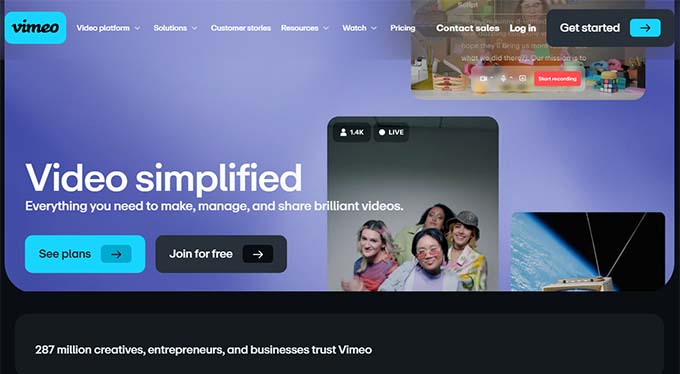
Vimeo also offers other features that can help improve your channel’s reach. For example, it has a search feature that allows users to search for videos, people, channels, and groups.
It also has a content discovery feature that shows relevant videos in the sidebar. However, by design, they are not as noticeable as on YouTube.
Similarly, Vimeo has a Groups feature where users can create and participate in groups. Users can also limit group content visible only to its members.
Plus, the platform shows staff picks on its homepage that are hand-selected by Vimeo’s staff.
4. Privacy Controls
Not all publishers want their content to be seen by everyone. For example, if you are selling online courses or running a video membership website, then you will want to restrict video access to paying subscribers only.
Let’s check out how both platforms allow publishers to control the privacy of their videos.
YouTube
YouTube offers three privacy settings for the videos that you upload on your channel:
- Public – These videos are publicly accessible by anyone. They can be searched, listed, and displayed all across YouTube.
- Unlisted – These videos can be accessible by anyone who has the URL. However, they will not appear in YouTube searches or related videos.
- Private – These videos are only visible to you and the specific users you choose.
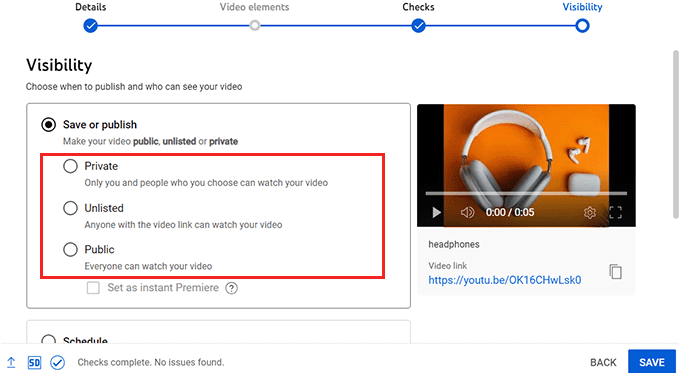
Apart from these settings, you can also disable comments or the like/dislike buttons on your videos.
Plus, YouTube lets you prevent the embedding of your videos on any website. Keep in mind that this setting will also block you from embedding videos on your own WordPress website.
Overall, YouTube is not the ideal platform if you want to host private videos.
Vimeo
In terms of privacy controls, Vimeo is superior to YouTube. It lets you make your videos public, private, or unlisted and even lets you hide them on Vimeo.
This means that your video can be embedded and viewed on your WordPress site, but it will not have a homepage on Vimeo.
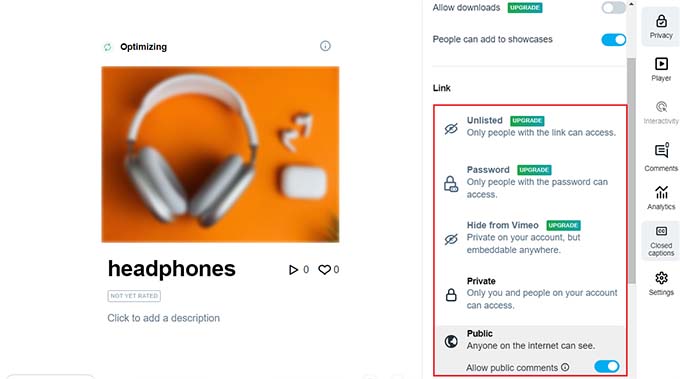
If you are using a paid plan, then you can also restrict video embeds to your website only. Plus, you can password-protect your videos so that only the users with the password can view and share them.
You can then add those videos to password-protected posts on your WordPress website.
If you want to have more control over who can watch your online videos, then Vimeo is a much better platform.
5. Video Editing
Both platforms offer great tools to upload, edit, and manage your videos. Let’s take a look at the video editing options for YouTube vs. Vimeo.
YouTube
YouTube offers powerful video editing features that allow you to create videos from your previously uploaded videos, photos, titles, and more.
You can also make videos using your videos and photos in Google Photos.
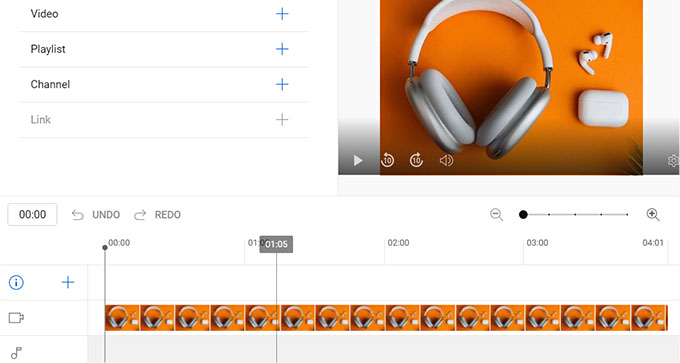
Their web-based video editing tools offer a simple and easy video-creating process where you can easily trim or crop any unwanted footage, add audio effects, add text and overlays to your videos, use transition effects, and more.
YouTube allows you to add links, annotations, captions, and subtitles to your videos. It also offers a live streaming feature where you can live broadcast events, news, or just casual vlogs.
Vimeo
Vimeo does not offer as many video editing features as YouTube. However, it does provide all the basics you’ll need.
It allows you to add video titles, descriptions, categories, tags, licenses, and audience ratings. You can also upload captions and subtitles to your videos.
However, Vimeo does not have annotation features, so you cannot add clickable links to your videos.
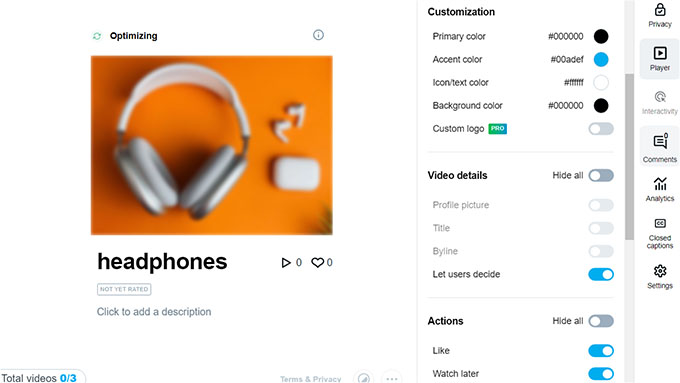
Some of Vimeo’s other editing features include trimming and cropping videos, audio effects, text overlays, transition effects, screen cards, color correction and grading, curve editing, custom watermarks, and more.
The best thing about Vimeo is that you can even replace your video with a newer version without having to change the video URL or stats. This is something that you cannot do on YouTube without uploading a new video with a totally new URL.
This specific feature is really handy because if you made a mistake or just need to update footage in your tutorials, then you can easily do so while keeping all the view count and the same video URLs. This also helps you keep your content fresh, which can help drive more traffic.
6. Monetization Options
Both platforms allow their users to make money online from their videos. Let’s compare Vimeo vs. YouTube for monetization options.
YouTube
YouTube allows content creators to join the YouTube partner program by signing up for Google AdSense to monetize their videos. Creators then get a cut of the ads displayed on their videos.
However, you will first need to be at least 18 years old, have 4,000 watch hours in the last 12 months, and have 1,000 subscribers on your YouTube channel to join the program.
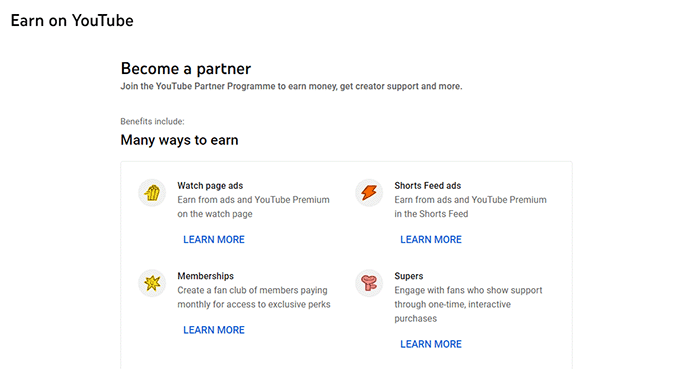
YouTube also allows content creators to use other monetization options.
For example, publishers can sell products in their videos, add paid reviews, join affiliate programs, get sponsors for their videos, ask for donations, and more.
Many of YouTube’s most popular content creators also use platforms like Patreon, where viewers can directly support their channel with donations.
Vimeo:
Vimeo prides themselves on offering an ad-free video platform because they do not have an advertising program that you can join to earn money.
However, they do offer a “Vimeo on Demand” feature where you can sell videos directly to viewers. You’ll need at least a Vimeo Pro account to join the program.
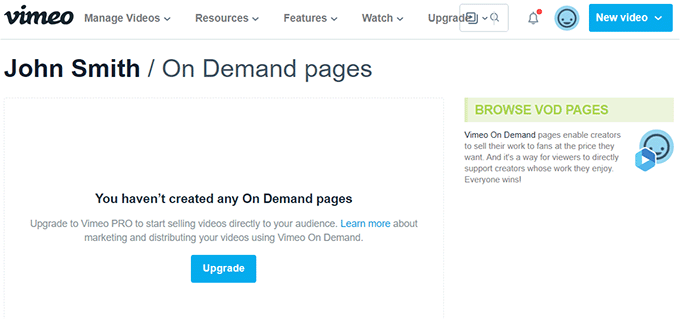
Similarly, you can also create and sell subscription plans that will allow viewers to access exclusive content like early access to new videos, behind-the-scenes content, and discounts on merchandise.
With Vimeo, you can even host live events like concerts, webinars, and workshops that users can pay to watch.
Another way to make money is to mention sponsors in your Vimeo videos, add links in video descriptions, and ask users to support your channel on platforms like Patreon.
YouTube vs. Vimeo – Which One Is Better?
YouTube and Vimeo are both great video hosting platforms that are easy to use. They offer excellent video editing features, make it super easy to embed videos on your website, and even provide many ways to make money online.
If you have just started a WordPress blog or have a small business and want to use videos to build a subscriber base and reach a much larger audience, then YouTube will be better for your goals.
However, if you have a website with membership options, sell courses, or host webinars or live events, then you will need more privacy and a top-notch viewing experience. That’s when Vimeo is a better choice.
Bonus: How to Embed TikTok Videos in WordPress
YouTube and Vimeo are two of the most popular video hosting platforms. If you are looking to reach an even larger audience, then you might also consider using TikTok.
This social media platform has more than 1 billion monthly users and is particularly popular among young audiences. You can also embed TikTok videos into your WordPress site to get more views, engagement, and social media followers.
By creating and adding TikTok videos to your site, you can improve your website’s SEO by making your content more helpful to users and even build brand awareness.
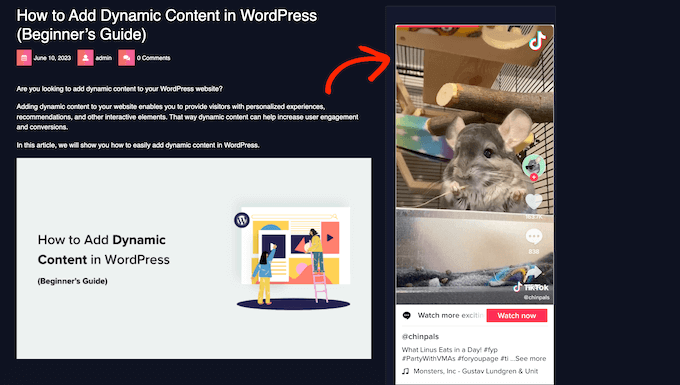
If you have a WooCommerce store, then you can also use the TikTok platform to showcase your products and increase conversions.
For detailed instructions, just see our tutorial on how to embed TikTok in WordPress.
We hope this article helped you learn more about YouTube vs Vimeo and which is better for your WordPress videos. You may also want to see our step-by-step guide on how to start a podcast and our comparison of the best video editing software.
If you liked this article, then please subscribe to our YouTube Channel for WordPress video tutorials. You can also find us on Twitter and Facebook.
پایان/
مرجع وب و فناوری
